Types of Fans
The fan is one of the many things that we require daily. In general, the human body can survive in most of the climate conditions on earth. But, to live comfortably, the general temperature of 37 degrees Celsius that the human body has, needs to be cooled down. The fan is of primordial importance in that process. At present times, there are several types of fans available in the market. Before jumping into the main topic – “types of fans“, let’s know some important things regarding fans.

The origin of fans can be traced back down to 3000 BC, right in the Greek civilization. Within the Greeks as well as in the Egyptian civilization, handheld fans of this kind that archaeologists found, were seen as a symbol of status and were of great importance and not to mention price. In the tomb of Tutankhamun, there were two intricately designed fans found. They were not only used for cooling down, but also for various ceremonial rituals.
Through the process of evolution, the fans became of a smarter and foldable nature near the 17th century. At that time, fans were again, used as a symbol of status, to show the royalty of nobles. The first manually operated ceiling fan was invented in India. Meanwhile, the first electric-powered ceiling fan was invented in 1882 by Philip Diehl.
After the industrial revolution, the uprise in the types of fans began, Nowadays fans mostly run on electricity like all other appliances. And it is now very easy to use also, you can just push the plug-in socket and enjoy an abundance of ventilation. Namely, there are 19 specific types of fans now, these are,
- Tower Fan
- Pedestal Fans
- Table Fan or Desk Fan
- Ceiling Fans
- Exhaust Fans
- Bladeless Fan
- Wall Mounted Fans
- Misting Fans
- AC and DC Motor Fans
- Industrial fans
- Hand Fans
- Rechargeable Fan
- Whole House Fans
- Floor Fans
- Centrifugal Fans
- Variable Pitch Fans
- Box Fans
- Attic Ventilator Fans
- Tubexial and Vane-axial Fans
1. Tower Fan

Tower fans are best known to be a handy household device that helps in cooling and dissipating heat. Agreeing with the name, tower fans come in the towering design of the narrow and tall structure and sleek body. Tower fans operate through the cooling panels installed in them that help in cooling the air where they are located. Most of the fans also have a rotating base that helps in keeping the air all around the place cool.
Nowadays, some of the tower fans also come with ionizers that are placed inside the fan in an inbuilt manner, this ionizer helps in the purification of the air. Tower fans are seen as a necessary aid of living in many households all around the globe. The quality and procedures of tower fans make them so different from the air cooler and also, they take up less space because of their size.
2. Pedestal Fans or Stand Fans
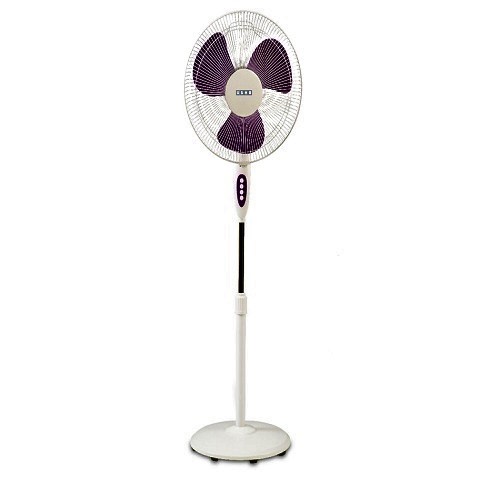
Pedestal fans are generally talked about because of their powerful cooling system and the strong jet of wind that they produce. These electric fans work based on oscillation with the help of a stand which can be detached from the body and also can be adjusted based on individual requirements and needs. Because of their extremely tall stature, these fans are also named stand fans.
These stand fans are built with an oscillation feature that helps in pushing the maximum quantity of air and also in equally maximum distribution. Unlike ceiling fans, pedestal fans are also very easy to use. Because of their loose nature and lightweight, pedestal fans can be carried around and turned on by just putting the plug in the socket.
3. Table Fan or Desk Fan
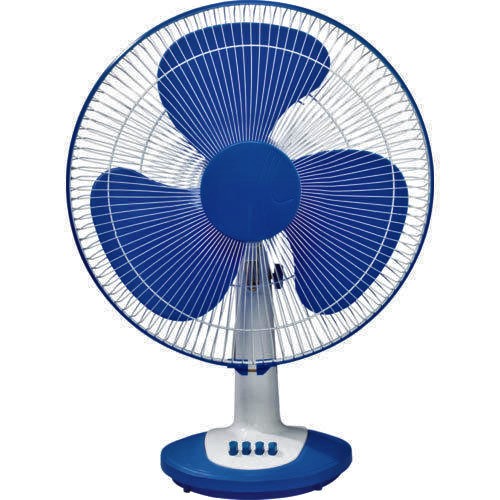
Table fans are probably the most sought fans after ceiling fans. Table fans are easily portable compact in size and can be used conveniently in any possible place. Most of the time, the table fans are electrically powered with one electric motor listed inside. Because of these various features and flexibility in use, table fans are used by most people in respect of their economic needs as well as their circumstances.
The table fans are the ones that horizontally provide air ventilation thus reaching a wider area and distributing evenly. The most important feature of table fans nowadays is that they come with various gadget control. Table fans can now be controlled via remote or even mobile phones, thus making the device one of the most desirable choices. Read Also: Purposes of Ventilation in House.
4. Ceiling Fans

The standard and most common type of fan is the ceiling fan. In most households, these mechanical fans can be seen being run by electricity and mounted from the ceiling of a room. The structure of a ceiling fan is pretty much simple, there are three to four hub-mounted blades and the full structure is hung from the ceiling preferably in the middle of a room.
Because of their suspended position and free rotation of the blades, ceiling fans can spread the air out evenly throughout the room. The use of ceiling fans can be traced back to 500 B.C. India was the origin of this fan, which back in the day was operated with the help of a cord, manually.
5. Exhaust Fans
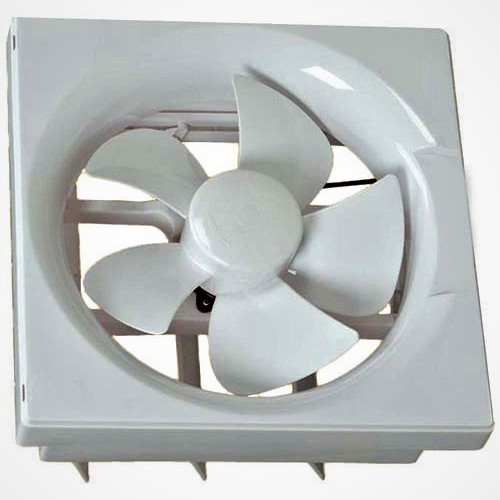
The main purpose of exhaust fans is to prevent excess heat by removing inside hot air from the building. These types of fans are generally used to provide proper ventilation in the building. These fans can be found most commonly in the bathroom and kitchen in any household. Like most of the others, exhaust fans also run on electricity and have a work structure commonly found in other fans except for the fact that the propelling action is done by the current passing through the system.
The exhaust fan’s blades rotate at a very high speed, thus pulling the hot air towards them and in turn, feeling the room with cold air. Nowadays, upgraded models of these fans also come with thermostats, where needed, these machines help in controlling the heat of the room. This type of fan is also commonly used in cinema halls and factories.
6. Bladeless Fan

As the name suggests, the bladeless fan does not have any external blade and it blows air from a ring or oval-shaped opening. This fan works with the help of vanes which are placed on the pedestal, these vanes, in turn, direct the airflow that is collected through the toroid. A bladeless fan blows a smooth airflow at a high velocity through the surface of the toroid, that too at a continuous pace.
The first concept of bladeless fans was given in 1981 by Toshiba and then, through proper development, the current models first appeared in 2009 by James Dyson. The action, by which the bladeless fan works, is called entrainment. In this process, the air surrounding the ring (toroid) flows in the external direction of the slit.
7. Wall-Mounted Fans
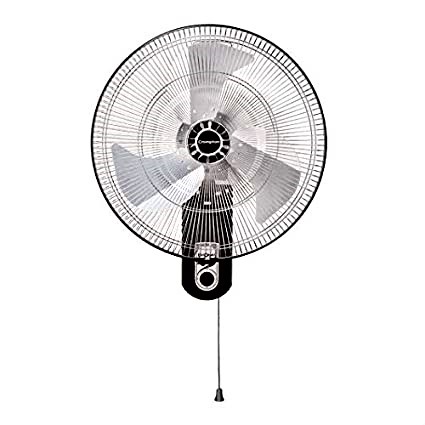
Mostly in workplaces where floor space is an issue and the room comprises either very low or very high and that too without proper wiring, the wall-mounted fans come to rescue. Wall-mounted fans are mostly used in auditoriums, offices, party halls, and even in warehouses. The most striking feature of wall-mounted fans is their work function and operation process.
Wall-mounted fans generally just push the air throughout the area where they are installed unlike the ceiling or other fans. Besides greatly helping with the air conditioning, wall-mounted fans also help in getting instant breeze and saving floor space. Their multiple speed setting, remote control features, durability, and lightweight structure make these fans one of the best in this field.
8. Misting Fans

Misting fans can be considered a great replacement for air conditioners. During the intense summer periods, misting fans can be of great help in the process of beating the heat. Misting fans need a continuous supply of water to do their duty. The water is squirted in the warm air through the high-pressure pumps, inbuilt into the fan, in the form of mist; thus, cooling the air.
The high-pressure pumps along with the powerful blower of these fans make them a very effective cooling gadget while keeping the space equally dry in both indoor and outdoor specs. No humidity can be felt on the skin regarding this mist. Misting fans are also the energy efficient option compared to air conditioning and they both give nearly similar results.
9. AC and DC Motor Fans

Both AC and DC motor fans are commonly used in various intricate circuits and electrical appliances. Also, all fans can be split into groups based on the motor, that they work with, namely AC and DC motors. The difference between AC and DC motors starts from their origin itself as the work function and processing of electricity of both these motors are starkly different.
The DC motor works on direct current and they are powered with the potential of a value that is fixed always like the voltage of a battery. On the contrary, the AC motor works on an alternating current, and they are powered with the potential of a value that is being alternated with an equal value of positive and negative voltage. The DC Motor fan is more energy–efficient than AC motor fan.
10. Industrial Fans

Industrial fans are also called industrial blowers. They have a simple objective of glowing a huge amount of air towards specific spaces or structures. They also are used in propelling gas toward specific structures or other industrial work. Industrial fans achieve this feat with the help of turbine motors which help them in processing the air both in larger quantities and at greater speed.
There is no fixed number of blades when it comes to industrial fans as the number can be adjusted as per requirement. The function of an industrial fan depends on the industry it is being used in as industrial fans can be used for various multipurpose works. Some of the most common examples of the work that industrial fan does are combustion, ventilation, air cleaning, drying, cooling, aeration, and others. Read Also: Method of Ventilation in Tunnels.
11. Hand Fans
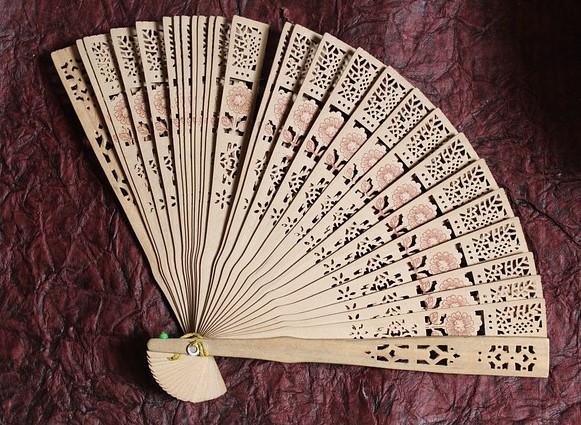
Hand fans are probably as old as the civilization itself, as, it is the first measure that humans invented for meeting the purposes of ventilation or cooling. Hand fans can be dated back to as long as 2000 B.C. The first, hand fans were used by the Egyptians who would consider them as a sacred objects; the hand fans can be found in various tombs in pyramids; the tomb of Tutankhamun had two very elaborately designed hand fans.
The hand fans depend on a very simple technique, there is one part to be held in hands and the other part expands into a much larger and wider structure which is used to push through the air, to create the flow. Hand fans are used by everyone irrespective of their financial condition and that too for various purposes, and as expected, it also comes in a plethora of different models and makes. The best thing about these types of fans is that you don’t have to rely on electricity.
12. Rechargeable Fan

An electrical device that can blow air without a continuous source of electricity is a rechargeable fan. It consists of rechargeable batteries that give power to the fan. In areas with predominantly hot weather, rechargeable fans are common. They are also seen by many as a summertime necessity. They can be used in places other than houses and offices, such as camping excursions and other outdoor activities.
Most rechargeable fans arrive completely built, as opposed to traditional fans, which need to be set up before use. Take it from the pack, connect it to charge, then turn it on when you’re ready to use it.
Rechargeable fans are typically designed to be portable. They are portable and versatile, working well in a dining room, kitchen, or in car.
Additionally, rechargeable fans use a lot less energy when charging, which might minimize your utility expenditures. The majority of rechargeable fans have a 12V DC motor, fan blade, charging circuit, power supply unit, and constructed housing as part of their system.
13. Whole House Fans
Whole House fans are generally used as the name suggests ventilating the “whole house“. Generally, these types of fans are placed in the attic of a building and are designed in such a way that they can ventilate the whole house and maintain a steady circulation of air. Due to their location, they are often confused with attic ventilators.
To measure the attic ventilation, the length and width of the attic need to be multiplied and then divided by 144. According to the thumb rule, for every 750 CFM of airflow, 1 square foot of ‘net free venting area’ is needed. Whole House fans provide the house with at least 15 to 23 air changes every day, in the process of cooling the whole house. Read Also: Factors Affecting Ventilation in Building.
14. Floor Fans

Floor fans get their name from their location, they are used to cool the floor level and that is why located right on that. Floor fans are especially useful in the case of hothouses to provide instant and good ventilation along with cooling effects. The most convenient thing about floor fans is that they do not require permanent installation which also gives them the added benefit of ceiling fans.
The floor fans can be utilized properly and that is why floor fans can be used even in the outdoor setting, on roofs, patios, and others. Nowadays, floor fans also come in various shapes and sizes and with some special abilities like inbuilt oscillation, 180-degree movement, till-able heads, and adjustable height.
15. Centrifugal Fans

Centrifugal fans are one type of industrial fan, completely different from the other axial types of industrial fans. These fans work with the help of their rotating disk present inside the fan, by attaining the centrifugal force. Centrifugal fans are used in both cases of gas and air, there are sharp plates mounted on the central disc at different calculated angles. The exterior of the centrifugal fans is scroll shaped thus lending them the nickname of the scroll or squirrel cage. The primary function of these fans is to provide a quick escalation of air or gas which is being passed through the fan system, and this feature is exploited in various industries.
16. Variable Pitch Fan
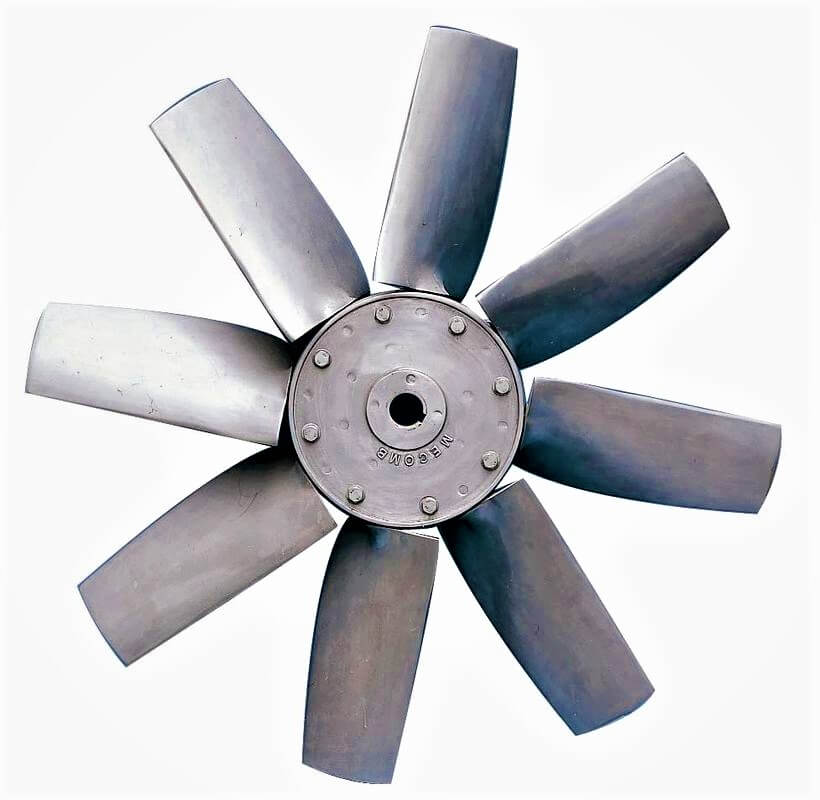
In concept, a variable-pitch fan is similar to a variable-pitch propeller. The mechanism of a variable pitch fan works through the process of progressive reduction of the blade angle (pitch) of the fan, which is placed on a turbofan, while the engine is being throttled. Variable pitch fans are mainly used in the engines of turbofans, with some occasional uses in the applications of various industries.
Though they are not much used in the production fans, they are likely to be used in the coming generation of turbofans with a higher bypass ratio. One of the primary uses of variable pitch fans in the turbofan is to improve propulsive efficiency, through the method of reducing fuel consumption which is thrust-specific.
17. Box Fans
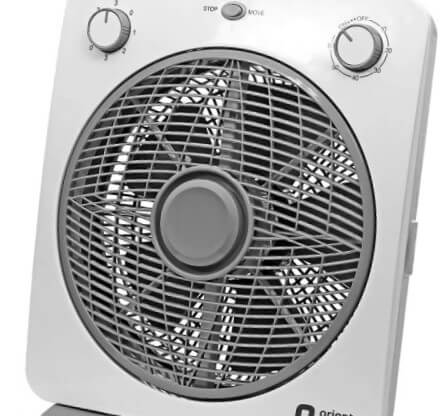
Box fans are another type of common household or industrially used fans. Box fans signify fans are comprised of rotating blades that are encased in a square metal frame. The frame that covers the rotating blades has slots open on both sides, for air to enter from one side and exit from the other, keeping the steady flow of air one way.
The most common uses of these fans are the circulation of air to keep it cool and eliminate odors. Box fans come in a plethora of varieties when it comes to size. Many portable fans now have a size of 5 inches by 5 inches while the common measurement of personal fans is 10 inches by 10 inches. The industrial standard size of box fans is 20 inches by 20 inches though.
18. Attic Ventilator Fan
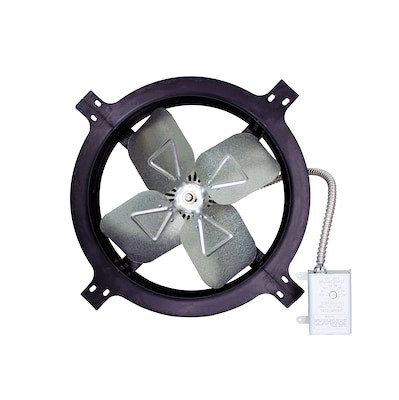
The basic work of an attic ventilator fan is as the name suggests, it blows heated air out of the attic to keep it cool and well-ventilated. Generally, an attic fan is also one kind of exhaust fan, that runs on electricity, commonly located either near the roof or near the gable.
Due to its location, it is often confused with the whole house fans, but whole house fans are supposed to run after sundown to provide cool air and even ventilation throughout the whole house while attic ventilator fans are designed to run throughout the whole day, especially the sunny days to clear the attic of the superheated air. The size and number of attic ventilator fans depend on the size of the roof.
19. Tube Axial and Vane-Axial Fan
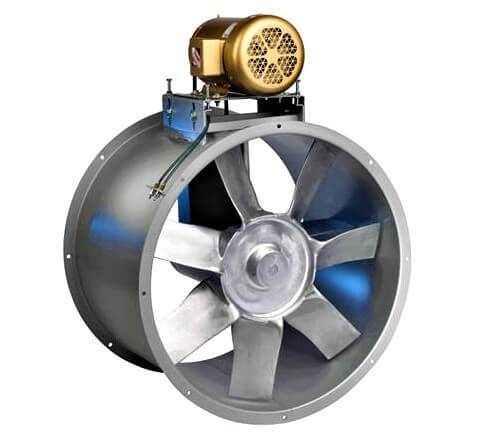
Axial fans are another type of industrial fan. The actual fans depend on the axial force to allow the movement of the blades. Axial fans are a specific type of fan that directs gas flow perpendicular to the shaft around which the blades rotate in an axial direction. At entries and exits, the flow is axial. The fan is made to create a pressure difference and, consequently, a force that will cause air to flow through it. The number and kind of blades are two elements that affect how well a fan works. Fans are used in a variety of places, such as cooling towers and wind tunnels. Flow rate, power, efficiency, and pressure rise are design parameters.
There are two types of axial fans present, tube axial and vane-axial. Tube axial fans are characterized by their medium pressure and high flow rate capability due to their non-existent guide vanes. On the other hand, vane-axial fans generally come equipped with either input or output guide vanes and are characterized by their high pressure and low flow rate performance. The fan casing and duct design both affect performance.
Most of these mentioned fans are available in the market for the common public, though it is advised to stick within the common types of ceiling and stand fans for personal uses. All the other types of fans have their designated uses and should only be used accordingly. Ventilation in a house or workplace is of utmost importance as without a proper ventilation system, the situation inside can be uncomfortable and unhealthy too.
To keep the supply of fresh air ongoing and to keep a healthy, comfortable, and fresh condition all around the house, proper use of fans is advised. Though we have mentioned ceiling fans and stand fans to be the advisable choices for personal use, new inventions like wall-mounted fans that can be remotely controlled, tower fans, and bladeless fans can also be used for that purpose. A tower fan is a great alternative to air conditioning systems, it consumes much less energy and does not emit any type of harmful gas.